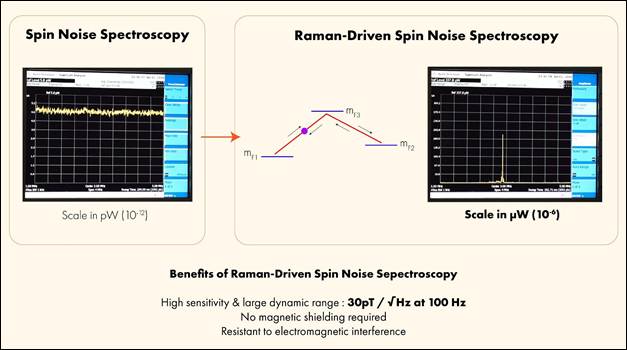A quantum leap in magnetometry could simplify magnetic field measurements
A quantum leap in magnetometry could simplify magnetic field measurements
Researchers have developed a new technology that could help measure the invisible forces of magnetism—from inside the human brain to the depths of outer space—without needing bulky shielding or ultra-quiet labs.
Magnetometers are useful devices with applications in areas ranging from fundamental physics to medical imaging and navigation. The most promising methods for magnetic field measurement are based on detecting polarization rotation of a probe light passing through alkali atoms in a very weak magnetic field. Magnetometers based on this method, referred to as Optically pumped atomic magnetometers (OPAMs) and Spin Exchange Relaxation Free (SERF) magnetometers, typically have high sensitivity but demand sophisticated magnetic shielding and have a lower dynamic range. These requirements make them difficult to be used as a field deployable device.
Researchers at the Raman Research Institute (RRI), an autonomous institution of the Department of Science and Technology (DST), have devised a novel method for magnetometry in an all-optical quantum magnetometer that could address these challenges. Based on Raman-Driven Spin Noise Spectroscopy (RDSNS), this method could transform the way we measure magnetic fields—making the process faster, portable and precise even in noisy, real-world environments.
This method exhibits potential for field-deployable applications of magnetic field measurement with broadband capability and fast time response, extending across various scientific, industrial and exploratory fields.
RDSNS uses laser light to listen to the tiny quantum jitters of Rubidium atoms. These jittery movements, called spin noise, are random fluctuations in the spin of atoms—fundamental quantum properties like tiny bar magnets. When exposed to a magnetic field, the pattern of this spin noise shifts in predictable ways. By shining lasers and analyzing the noise, researchers can accurately measure the magnetic field without touching or disturbing the atoms. RDSNS enhances the dynamic range considerably without significant loss of sensitivity.

Fig 1. How RDSNS increases the magnetic resonance signal & its benefits
“We have combined high sensitivity with an unusually large dynamic range—something that is extremely difficult to achieve,” said Sayari, a PhD researcher and the study’s lead author. Most magnetometers have to trade-off between these two traits. But RDSNS works beautifully across a wide range of field strengths—from very weak to very strong—without sacrificing precision.
Their setup works without magnetic shielding. That means, it can be used in outdoor, industrial and clinical environments where other magnetometers fail. It is compact, fully optical (no moving parts) and immune to electrical interference.
Their device achieved a sensitivity of 30 picotesla per root hertz at 100 Hz—approaching the sensitivity of bulky lab systems—while fitting into a system that could one day be portable.
The technique yields similar sensitivity even under the presence of external stray fields broadening the applicability of RDSNS to many more applications, like deployable atomic magnetometers that can run under environments with fluctuating magnetic fields. The technique is also insulated against interference due to stray RF noise and mechanical vibrations, typical issues for other magnetometer technologies.
The method could revolutionize how we scan the brain and nervous system—offering an alternative to MRI that is silent, compact, and non-invasive. Prospectors could use these sensors to detect underground magnetic variations hinting at mineral deposits. In space, where weight and robustness matter, a portable, shield-free magnetometer is invaluable for studying magnetic fields around planets and stars.
The relevant research article was recently published in the journal IEEE Transactions on Instrumentation and Measurement through an initiative under the National Quantum Mission of DST.
“Our approach reflects India’s growing ambition in the global quantum technology race,” said Dr. Saptarishi Chaudhuri, who leads the Quantum Mixtures (QuMIX) lab at RRI. “We are using atoms—nature’s quantum building blocks—to design next-generation sensors.”
The RRI team envisions using phase-locked lasers to further enhance stability, integrating squeezed light to reduce quantum noise and building miniaturized versions using MEMS technology—tiny mechanical systems etched onto chips. In the long run, RDSNS might even help probe deep quantum mysteries, such as how atoms interact or how complex quantum phases emerge.